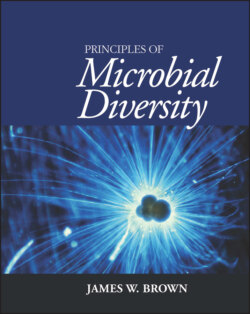Читать книгу Principles of Microbial Diversity - James W. Brown - Страница 2
Table of Contents
Оглавление1 Cover
2 Preface
3 Acknowledgments
4 About the Author
5 SECTION I: Introduction to Microbial Diversity 1 What Is Microbial Diversity? Facets of microbial diversity The fundamental similarity of all living things 2 Context and Historical Baggage The evolution of evolutionary thought Taxonomy and phylogeny The false eukaryote-prokaryote dichotomy 3 Phylogenetic Information Deciding which organisms and sequences to use in the analysis Obtaining the required sequence data Assembling sequences in a multiple-sequence alignment 4 Constructing a Phylogenetic Tree Tree construction: the neighbor-joining method How to read a phylogenetic tree Example analysis 5 Tree Construction Complexities Substitution models Treeing algorithms Bootstrapping 6 Alternatives to Small-Subunit rRNA Analysis SSU rRNA cannot be used to distinguish closely related organisms Alternative sequences Alternatives to sequence-based methods 7 The Tree of Life Major lessons of the “Big Tree of Life” Rooting the “Tree of Life” The caveat of horizontal transfer
6 SECTION II: The Microbial Zoo 8 Primitive Thermophilic Bacteria Phylum Aquificae (Aquifex and relatives) Phylum Thermotogae (Thermotoga and relatives) Other primitive thermophiles Thermophilic ancestry of Bacteria Life at high temperatures 9 Green Phototrophic Bacteria Phylum Chloroflexi (green nonsulfur bacteria) Phylum Chlorobi (green sulfur bacteria) Phylum Cyanobacteria (blue-green algae) Other green phototrophs Bacterial photosynthesis Carbon fixation 10 Proteobacteria Phylum Proteobacteria (purple bacteria and relatives) Class Alphaproteobacteria Class Betaproteobacteria Class Gammaproteobacteria Class Deltaproteobacteria Class Epsilonproteobacteria The concept of “proteobacteria” 11 Gram-Positive Bacteria What does being gram positive mean? An alternative view of gram-positive bacteria Phylum Firmicutes (low-G∙C gram-positive bacteria) Phylum Actinobacteria (high-G∙C gram-positive bacteria) Bacterial development Bacterial multicellularity 12 Spirochetes and Bacteroids Phylum Spirochaetae Phylum Bacteroidetes (sphingobacteria or Bacteroides/Flavobacterium/Cytophaga group) Bacterial motility 13 Deinococci, Chlamydiae, and Planctomycetes Phylum Deinococcus-Thermus Phylum Chlamydiae (Chlamydia and relatives) Phylum Planctomycetes (Planctomyces and relatives) Reductive evolution in parasites 14 Bacterial Phyla with Few or No Cultivated Species How do we know about these organisms? Phyla with few cultivated species Phyla with no cultivated species Phylogenetic groups at all levels are dominated by uncultivated sequences How much of the microbial world do we know about? 15 Archaea General properties of the Archaea Phylum Crenarchaeota Phylum Euryarchaeota Phylum Korarchaeota Phylum Nanoarchaeota Archaea as … 16 Eukaryotes General properties of the eukaryotes Unikonta Plantae Chromalveolata Rhizaria Excavata 17 Viruses and Prions Viruses Prions
7 SECTION III: Microbial Populations 18 Identification of Uncultivated Organisms 19 Sequence-Based Microbial Surveys 20 Fluorescent In Situ Hybridization Surveys Fluorescent in situ hybridization Confocal laser scanning microscopy 21 Molecular Fingerprinting of Microbial Populations Denaturing gradient gel electrophoresis Terminal restriction fragment length polymorphism 22 Linking Phenotype and Phylotype The genomic or metagenomic approach The stable-isotope probing approach
8 SECTION IV Conclusion: The Phylogenetic Perspective 23 Genomics, Comparative Genomics, and Metagenomics Genomics Comparative genomics Metagenomics 24 Origins and Early Evolution The timescale Ancient microbial fossils The last common ancestor The RNA world hypothesis The emergence of life
9 Index
10 End User License Agreement
